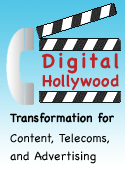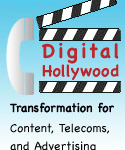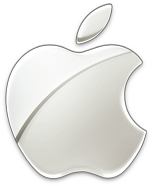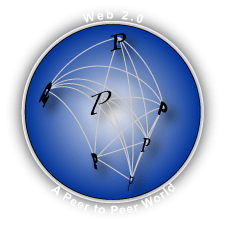Consumer Mistrust Will Slow the Reality of Mobile Personalization Vision
 Panelists at Digital Hollywood Chicago constantly spoke about mobile as the most “personal” of the three screens—for several reasons. The phone number is individual, so all the device’s activity can be attributed to a person, whose preferences and needs can be deduced from the activity. In addition, the mobile (phone) accompanies the individual almost everywhere, so it offers a wide scope of visibility into his/her activities, location and interactions. Panelists at Digital Hollywood Chicago constantly spoke about mobile as the most “personal” of the three screens—for several reasons. The phone number is individual, so all the device’s activity can be attributed to a person, whose preferences and needs can be deduced from the activity. In addition, the mobile (phone) accompanies the individual almost everywhere, so it offers a wide scope of visibility into his/her activities, location and interactions.
The mobile device will soon lose the “phone” moniker because the device morphing into a portable digital hub. “Smartphones” have seen much slower adoption than hoped, but functionality, power and capability are steadily increasing while prices fall. Apple’s iPhone was constantly mentioned as the promising breakthrough device.
Mobile devices will change relationships far more than the first screen (TV) or the second screen (computer) because they will touch everyone, their capabilities will rival laptops’ within 2-3 years, and they are inherently social. Social networking via video sharing, Web browsing, email, SMS, IM, music sharing and voice calling is on tap in the latest smartphones. The problem is, their features […]
The Challenge of Consumer/Advertising Misalignment: How to Finance Free Content
 At Digital Hollywood Chicago, few disputed that broadcast TV and mass advertising’s golden age had passed and that several technologies and cultural shifts were pressuring senior marketers to change. To fully appreciate this challenge, one has to consider the three screens through which most consumers experience “content. ” What consumers do with the changing capabilities of each screen changes their expectations and behaviors about their experience with all three screens, dramatically increasing opportunities and threats. Interactivity is increasingly available for TV (video). Convergence among the three screens is another important thread. Younger generations of consumers have little tolerance for the concept of mass advertising. At Digital Hollywood Chicago, few disputed that broadcast TV and mass advertising’s golden age had passed and that several technologies and cultural shifts were pressuring senior marketers to change. To fully appreciate this challenge, one has to consider the three screens through which most consumers experience “content. ” What consumers do with the changing capabilities of each screen changes their expectations and behaviors about their experience with all three screens, dramatically increasing opportunities and threats. Interactivity is increasingly available for TV (video). Convergence among the three screens is another important thread. Younger generations of consumers have little tolerance for the concept of mass advertising.
The most rapacious symptom of the weakness of the mass broadcast advertising model is the widespread adoption of the PVR (personal video recorder), which enables (home) viewers to record TV programs—and to skip advertisements. A couple of eye-opening facts: 1) on average, TV programming contains 8.5 minutes of advertisements during each 30 minute segment of programming and 2) 70% of adverts are fast-forwarded through or eliminated. And these numbers pertain to (mostly) non-digital (analog) […]
Mobile Video: A Perfect Storm for User-Generated Content?
 At Digital Hollywood Chicago, mobile was constantly heralded as the emerging “third screen” because it would enable content consumption regardless of time or place, and most speakers posited that video would grow significantly as a portion of all content. However, there is little video content available for mobile viewing, so why should consumers get excited about it? Will mobile shine as the most personal view into the consumer, or will it turn out to be the third wheel? At Digital Hollywood Chicago, mobile was constantly heralded as the emerging “third screen” because it would enable content consumption regardless of time or place, and most speakers posited that video would grow significantly as a portion of all content. However, there is little video content available for mobile viewing, so why should consumers get excited about it? Will mobile shine as the most personal view into the consumer, or will it turn out to be the third wheel?
All mobile value chain players are frenetically trying to build a new digital world around the mobile device, and this world will be comprised of the familiar triad: devices, networks and content, much of which will be video. Currently, video is the highest value content medium. This session examined the current stage of development to technology and business models.
Internet pioneers who remember the thrill of squealing modems connecting in the early days have a useful metaphor with which to regard video on mobile. We are very much in the early days: networks in most geos are inconsistent, and their ability to […]
Now Everyone Is a Producer—How Will User-Generated Content Affect Traditional Media?
 User-generated media (UGM) represents a poignant dichotomy within the context of Digital Hollywood Chicago: panelists and speakers represented a full spectrum of players that provide the capability for people to communicate, work and entertain themselves, but they have in common that they represent business interests. These players are in the business of commercializing communication. Consumers (aka “users,” “people”) represent personal interests: they communicate because they want to; they have little commercial interest in most of their communication. User-generated media (UGM) represents a poignant dichotomy within the context of Digital Hollywood Chicago: panelists and speakers represented a full spectrum of players that provide the capability for people to communicate, work and entertain themselves, but they have in common that they represent business interests. These players are in the business of commercializing communication. Consumers (aka “users,” “people”) represent personal interests: they communicate because they want to; they have little commercial interest in most of their communication.
Panelists grappled with this reality but did not address it directly. They explored business models for UGM—and mostly came up empty. The problem that UGM poses to providers is two-fold: UGM costs providers money in terms of bandwidth and other resources. It also carries a considerable opportunity cost, which is hard to measure but palpable: it crowds out commercial content by occupying customers in two ways: creating UGM and experiencing others’ UGM.
UGM is also difficult to compete against because its producers play by much different rules: they usually produce for free, while commercial producers have high costs. UGM producers […]
Redefining the Industry to Remain Relevant—The Significance of AT&T’s Big Bet on Mobile
 At Digital Hollywood Chicago, AT&T was busy redefining itself as a 21st century communications provider, and we believe that will increasingly mean focusing on content to provide profits. An AT&T veteran but new in 2007 as CEO, Randall Stephenson keynoted the conference by sharing his vision for AT&T and the future of the industry. At Digital Hollywood Chicago, AT&T was busy redefining itself as a 21st century communications provider, and we believe that will increasingly mean focusing on content to provide profits. An AT&T veteran but new in 2007 as CEO, Randall Stephenson keynoted the conference by sharing his vision for AT&T and the future of the industry.
Telecoms provide the network infrastructure of distributed computing and global communications, but infrastructure is a tough business with thin margins and high capital requirements. All telecoms are trying to move up the value chain to escape commoditization pressure and relentless price competition. For example, Sprint is betting heavily on WiMAX to redefine itself as the enabler of digital relationships.
In the context of telecoms redefinition, AT&T’s alliance with Apple could be very strategic for each company, as AT&T can use Apple’s design excellence to increase subscribers and push advanced network services while Apple needs a telecom partner to drive its relevance in the growing third screen market with the iPhone. According to Stephenson, the […]
Reading between the Lines: Apple’s New Business Strategy reveals why Apple could emerge as a three-screen player par excellence.
 Apple’s name change in early 2007 was heralded as the company’s redefinition as a consumer products company. The conventional wisdom held that the lion’s share of the run-up of Apple’s stock price had been due to the excitement of the iPod and the successful rekindling interest in the company’s Macintosh computers. Moreover, Apple’s stock had limited headroom because consumer electronics heavies were getting into the market for music players, and this would leech profits. The iPhone looked great, but it was overpriced in a hyper-competitive market; it wouldn’t penetrate much beyond a few gadget freaks. Apple’s name change in early 2007 was heralded as the company’s redefinition as a consumer products company. The conventional wisdom held that the lion’s share of the run-up of Apple’s stock price had been due to the excitement of the iPod and the successful rekindling interest in the company’s Macintosh computers. Moreover, Apple’s stock had limited headroom because consumer electronics heavies were getting into the market for music players, and this would leech profits. The iPhone looked great, but it was overpriced in a hyper-competitive market; it wouldn’t penetrate much beyond a few gadget freaks.
This prevailing view works great for Apple because it keeps people focused on the wrong things—literally. Apple’s business strategy is far more profound. It goes far beyond the SIC, hardware or even software. It is an experience strategy based on content and communications.
[…]
Rebooting Kraft—CEO Outlines Growth Strategy clearly shows the innovation imperative: A Play in Two Acts, Starring the Consumer.
 Irene B. Rosenfeld, Chairman & Chief Executive Officer of Kraft Foods, outlined her vision for relaunching Kraft at the Executives’ Club of Chicago’s Chicago CEO Breakfast on May 30, 2007 at the Mid-America Club. She was enthusiastic about the company’s second lease on life: having spun off of Altria this spring, the company is newly independent, and she was eager to share her plan to drive growth by addressing the “eye of the consumer.” Irene B. Rosenfeld, Chairman & Chief Executive Officer of Kraft Foods, outlined her vision for relaunching Kraft at the Executives’ Club of Chicago’s Chicago CEO Breakfast on May 30, 2007 at the Mid-America Club. She was enthusiastic about the company’s second lease on life: having spun off of Altria this spring, the company is newly independent, and she was eager to share her plan to drive growth by addressing the “eye of the consumer.”
Kraft Foods is the second largest food company in the world and the largest in North America. It has seven brands that produce revenue of over $1 billion and fifty that bring in over $100 million each. Central to her strategy is leveraging Kraft’s formidable brand portfolio and other economies of scale. Rosenfeld “came home to Kraft” about a year ago, having had highly visible leadership roles at the company in the past and the top job at Frito-Lay immediately prior.
[…]
The Internet, E-Business and Web 2.0 in Context
 Web 2.0 and social networks readily appear as hype, but I will argue that they are actors in a much larger drama, the emergence of the Knowledge Economy, which is currently in its third phase, Web 2.0 and social networks. By understanding the transformation of relationships among your customers and between your customers and your company, you will be in a much better position to guide your company through this area of tremendous change. Web 2.0 and social networks readily appear as hype, but I will argue that they are actors in a much larger drama, the emergence of the Knowledge Economy, which is currently in its third phase, Web 2.0 and social networks. By understanding the transformation of relationships among your customers and between your customers and your company, you will be in a much better position to guide your company through this area of tremendous change.
The Ascendance of the Knowledge Economy
The Knowledge Economy is a post-industrial economy in which value is primarily created through information, and differentiation is achieved by explicitly focusing on customer experience itself rather than on products or services. The life cycles of products and services will increasingly shorten. Leaders of companies with products and services who do not understand this face rampant commoditization from which there is no escape except through unprecedented innovation. We are in the third phase of the growth of the Knowledge Economy in which it is transforming relationships. Each phase is ongoing, but the emphasis shifts over […]
![Payment Processor Wins Web 0.2 Citation for Delivering "Yechsperience" [customer experience satire]](http://rollyson.net/wp-content/uploads/2007/03/webdot2-logo.png) Achieves Payor of Last Resort Status Achieves Payor of Last Resort Status
Chicago, 13 March 2007—Today, the Global Human Capital Journal awarded StaySmall, the global payment intermediary, the odious Web 0.2 Citation for inducing a poignant bout of customer yechsperience™.
As readers know, the GHCJ exercises stringent criteria before conferring the Web 0.2 Citation: to earn it, companies must induce prolonged feelings of frustration, confusion and anguish in customers more effectively than their competitors.
Tonight, StaySmall delivered in spades, as reported by the judges. Here is a summarized account of the findings…
[…]
Web 2.0 Is Transforming Relationships Between Customers and Companies*
 I’ll risk using a hype-laden term like “Web 2.0” in the title: I think most of us have been around long enough to understand that hype doesn’t mean that nothing is there, although it can distract us from seeing things that we should be watching. I’ll risk using a hype-laden term like “Web 2.0” in the title: I think most of us have been around long enough to understand that hype doesn’t mean that nothing is there, although it can distract us from seeing things that we should be watching.
I have been in the thick of the “adoption curves” of Java, e-business transformation and SOA/Web services (detail). They have been instrumental in creating a new information infrastructure and business process capabilities. “Web 2.0” will prove to be the most transformational so far because it is changing relationships. It changes individuals’ relationships with each other, and it will change how companies and the customers relate to each other. It will demand “Marketing 2.0.”
Tectonic Shift
As I argued in The 3.x Economies, we are transitioning away from the Industrial Economy and entering the Knowledge Economy. In the Industrial Economy, companies created value by manufacturing products efficiently based on their core competencies, and they marketed products to customers. They also created and marketed services on a large scale. “Marketing” grew as a profession during the 20th century when […]
|
|
 Panelists at Digital Hollywood Chicago constantly spoke about mobile as the most “personal” of the three screens—for several reasons. The phone number is individual, so all the device’s activity can be attributed to a person, whose preferences and needs can be deduced from the activity. In addition, the mobile (phone) accompanies the individual almost everywhere, so it offers a wide scope of visibility into his/her activities, location and interactions.
Panelists at Digital Hollywood Chicago constantly spoke about mobile as the most “personal” of the three screens—for several reasons. The phone number is individual, so all the device’s activity can be attributed to a person, whose preferences and needs can be deduced from the activity. In addition, the mobile (phone) accompanies the individual almost everywhere, so it offers a wide scope of visibility into his/her activities, location and interactions.
 At Digital Hollywood Chicago, mobile was constantly heralded as the emerging “third screen” because it would enable content consumption regardless of time or place, and most speakers posited that video would grow significantly as a portion of all content. However, there is little video content available for mobile viewing, so why should consumers get excited about it? Will mobile shine as the most personal view into the consumer, or will it turn out to be the third wheel?
At Digital Hollywood Chicago, mobile was constantly heralded as the emerging “third screen” because it would enable content consumption regardless of time or place, and most speakers posited that video would grow significantly as a portion of all content. However, there is little video content available for mobile viewing, so why should consumers get excited about it? Will mobile shine as the most personal view into the consumer, or will it turn out to be the third wheel? At Digital Hollywood Chicago, AT&T was busy redefining itself as a 21st century communications provider, and we believe that will increasingly mean focusing on content to provide profits. An AT&T veteran but new in 2007 as CEO, Randall Stephenson keynoted the conference by sharing his vision for AT&T and the future of the industry.
At Digital Hollywood Chicago, AT&T was busy redefining itself as a 21st century communications provider, and we believe that will increasingly mean focusing on content to provide profits. An AT&T veteran but new in 2007 as CEO, Randall Stephenson keynoted the conference by sharing his vision for AT&T and the future of the industry. Apple’s name change in early 2007 was heralded as the company’s redefinition as a consumer products company. The conventional wisdom held that the lion’s share of the run-up of Apple’s stock price had been due to the excitement of the iPod and the successful rekindling interest in the company’s Macintosh computers. Moreover, Apple’s stock had limited headroom because consumer electronics heavies were getting into the market for music players, and this would leech profits. The iPhone looked great, but it was overpriced in a hyper-competitive market; it wouldn’t penetrate much beyond a few gadget freaks.
Apple’s name change in early 2007 was heralded as the company’s redefinition as a consumer products company. The conventional wisdom held that the lion’s share of the run-up of Apple’s stock price had been due to the excitement of the iPod and the successful rekindling interest in the company’s Macintosh computers. Moreover, Apple’s stock had limited headroom because consumer electronics heavies were getting into the market for music players, and this would leech profits. The iPhone looked great, but it was overpriced in a hyper-competitive market; it wouldn’t penetrate much beyond a few gadget freaks. Irene B. Rosenfeld, Chairman & Chief Executive Officer of Kraft Foods, outlined her vision for relaunching Kraft at the Executives’ Club of Chicago’s Chicago CEO Breakfast on May 30, 2007 at the Mid-America Club. She was enthusiastic about the company’s second lease on life: having spun off of Altria this spring, the company is newly independent, and she was eager to share her plan to drive growth by addressing the “eye of the consumer.”
Irene B. Rosenfeld, Chairman & Chief Executive Officer of Kraft Foods, outlined her vision for relaunching Kraft at the Executives’ Club of Chicago’s Chicago CEO Breakfast on May 30, 2007 at the Mid-America Club. She was enthusiastic about the company’s second lease on life: having spun off of Altria this spring, the company is newly independent, and she was eager to share her plan to drive growth by addressing the “eye of the consumer.” Web 2.0 and social networks readily appear as hype, but I will argue that they are actors in a much larger drama, the emergence of the Knowledge Economy, which is currently in its third phase, Web 2.0 and social networks. By understanding the transformation of relationships among your customers and between your customers and your company, you will be in a much better position to guide your company through this area of tremendous change.
Web 2.0 and social networks readily appear as hype, but I will argue that they are actors in a much larger drama, the emergence of the Knowledge Economy, which is currently in its third phase, Web 2.0 and social networks. By understanding the transformation of relationships among your customers and between your customers and your company, you will be in a much better position to guide your company through this area of tremendous change.![Payment Processor Wins Web 0.2 Citation for Delivering "Yechsperience" [customer experience satire]](http://rollyson.net/wp-content/uploads/2007/03/webdot2-logo.png) Achieves Payor of Last Resort Status
Achieves Payor of Last Resort Status  I’ll risk using a hype-laden term like “Web 2.0” in the title: I think most of us have been around long enough to understand that hype doesn’t mean that nothing is there, although it can distract us from seeing things that we should be watching.
I’ll risk using a hype-laden term like “Web 2.0” in the title: I think most of us have been around long enough to understand that hype doesn’t mean that nothing is there, although it can distract us from seeing things that we should be watching.